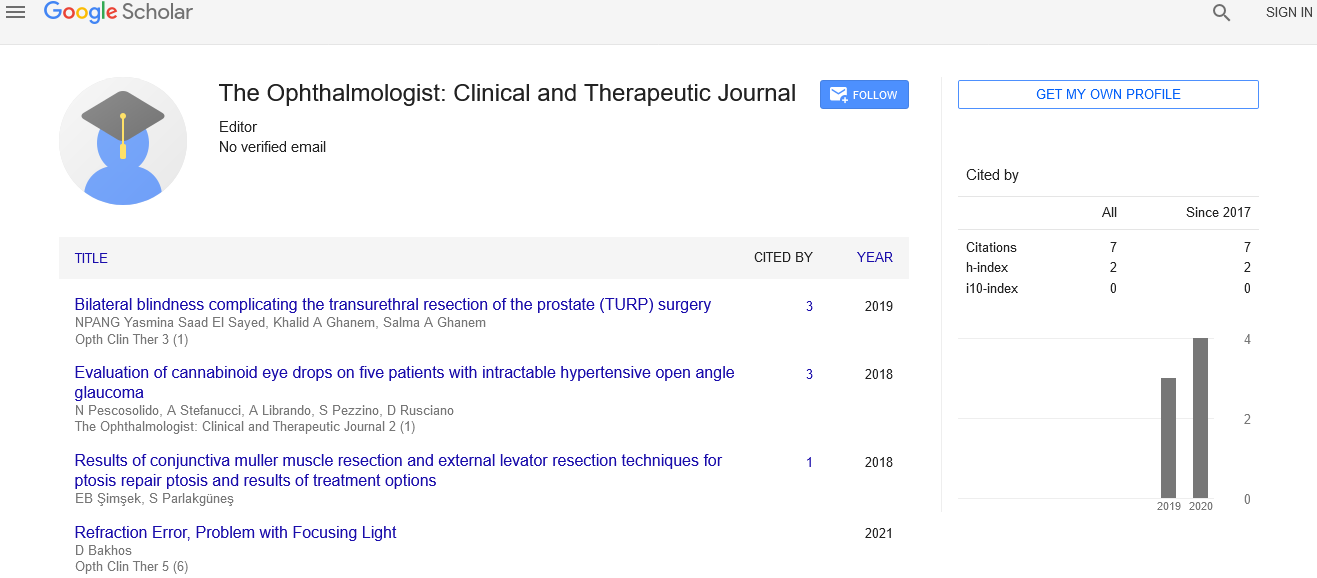Recapitulation of diabetic retinopathy
Received: 05-Jan-2021 Accepted Date: Jan 19, 2021; Published: 29-Jan-2021
Citation: Melendez J. Recapitulation of diabetic retinopathy. Opth Clin Ther. 2021;5(1):1.
This open-access article is distributed under the terms of the Creative Commons Attribution Non-Commercial License (CC BY-NC) (http://creativecommons.org/licenses/by-nc/4.0/), which permits reuse, distribution and reproduction of the article, provided that the original work is properly cited and the reuse is restricted to noncommercial purposes. For commercial reuse, contact reprints@pulsus.com
Abstract
Diabetic retinopathy is a blood glucose or blood sugar complication that influences and affects eyes. It was caused due to damage to the blood vessels of the light-protective and sensitive tissue which are located at the back of the eye (retina). At initial stages, diabetic retinopathy might not show any visual symptoms or only mild vision problems. Progressively, it has ability to cause blindness. This condition can develop in any patient who is with Type I or Type II diabetes. The actual risk factor lies in the severity of blood glucose levels and time period of suffering from diabetes. As the glucose levels increases the ocular pressure increases leading to more complications.
Description
Diabetic retinopathy is a blood glucose or blood sugar complication that influences and affects eyes. It was caused due to damage to the blood vessels of the light-protective and sensitive tissue which are located at the back of the eye (retina).
At initial stages, diabetic retinopathy might not show any visual symptoms or only mild vision problems. Progressively, it has ability to cause blindness. This condition can develop in any patient who is with Type I or Type II diabetes. The actual risk factor lies in the severity of blood glucose levels and time period of suffering from diabetes. As the glucose levels increases the ocular pressure increases leading to more complications.
The symptoms for diabetic retinopathy may include spots or dark strings floating in your vision (floaters), blurred vision, fluctuating vision, impaired color vision, dark or empty areas in your vision, vision loss. It was always safe to check the condition of the eyes for patients with diabetes by consulting their physician. One can go for yearly examination of eyes checking for dilation of the pupils. In some cases diabetic patients with pregnancy are more likely to get Diabetic retinopathy.
The actual cause of diabetic retinopathy was due to high blood glucose levels that lead to the blockage of blood supply to the eyes resulting in reduction of nourishment to the eyes. As a result the eyes are developing the new blood vessels for blood supply, but on the other hand the newly formed blood vessels are damaging leading to the leakage and oedema.
There are two types of Diabetic Retinopathy based on the severity in condition. They are early diabetic retinopathy and advanced diabetic retinopathy. The Early diabetic retinopathy was also known to be Non-Proliferative Diabetic Retinopathy (NPDR). The blood vessels are not proliferating completely to the retina resulting in the formation of micro aneurysms, which is the formation of small bulges from the walls of arteries or blood vessels. These micro aneurysms protrude to the walls of blood vessels making the blood fluids leak into the retina
This is the condition where the blood vessels in the retina were blocked due to high glucose levels leading to the formation of new blood vessels causes the leakage of clear, jelly-like substance that fills the centre of your eye (vitreous). Gradually the scar tissue gets stimulated by the growth of new blood vessels. In some cases the blood vessels interact with the existing blood vessels causing pressure in the eyeball that may damage the optic nerve which may affect the vision.
The probable risk factors in diabetic retinopathy include duration of diabetes, poor control of your blood sugar level, high blood pressure, high cholesterol, pregnancy, use of tobacco. The complications may involve Vitreous haemorrhage, Retinal detachment, Glaucoma, Blindness.
The best diagnostic test for diabetic retinopathy was comprehensive dilated eye exam. In this test drops were places in the eye, and ophthalmologist looks for complications in the vision by observing the abnormal blood vessels, swelling, blood or fatty deposits in the retina, growth of new blood vessels and scar tissue, bleeding in the clear, jelly-like substance that fills the centre of the eye (vitreous), retinal detachment, abnormalities in your optic nerve.
The treatment options are photocoagulation, panretinal photocoagulation, vitrectomy, injecting medicine into the eye. The only prevention to this is by manage and monitor the blood glucose levels, avoiding smoking and alcohol, regular exercise, controlling the blood pressure and cholesterol. Keep our eyes healthy with regular check-ups in vision.
Conclusion
I thank all reviewers for their excellent contributions. At this stage we are calling for submissions of articles, commentaries, and letters to the editor for the upcoming issues. We glance forward to receiving your exciting contribution. Finally, I would like to thank you, the contributors and readers for your interest in the journal and I encourage you to continue to send us your valuable feedback and ideas for further improvement of our journal.





